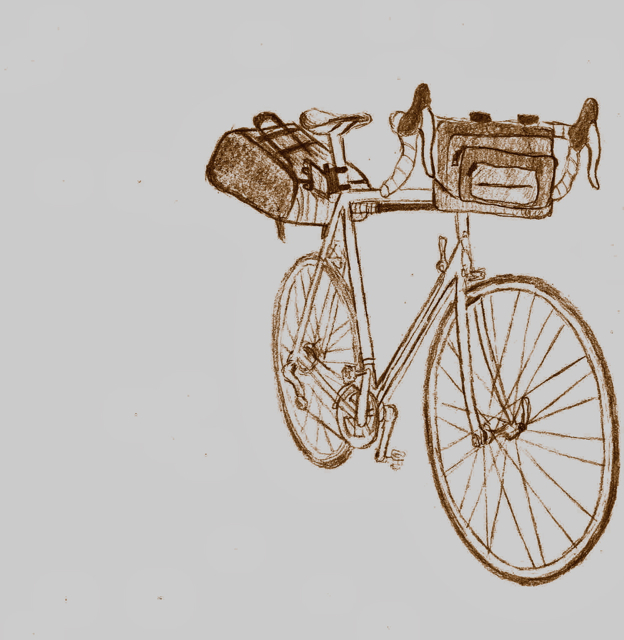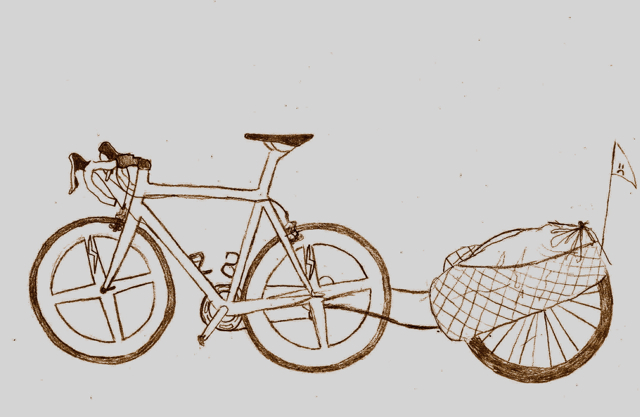(All illustrations by Anna E.)
Okay, so you’re going to tour on your road bike. That’s a great idea. How do you carry your stuff? The far and away easiest way is to grab a 20-40 liter rucksack, fill it, and go. This was Sprocket’s strategy when we rode the Camino de Santiago. But long days cycling with a backpack ultimately aren’t particularly comfortable, yielding an achy neck and shoulders and certainly a sweaty back. You are far better off securing the bulk of the load to the bicycle. Here are some ways to do that on a bike that is not necessarily designed for touring.
These methods assume that you are traveling quite light. They can, of course, in many cases be usefully mixed and combined.
RACK WITH PANNIERS
Two panniers on a rear rack is a commonplace in touring. Packing and unpacking is very easy, removing the panniers is usually effortless, and there are panniers to fit any budget. As long as the panniers are small and not overloaded, traveling this way is completely straightforward. (Yes, even if the rear triangle of your bicycle is carbon fiber. The 25 extra lbs. you are adding will make no difference.)
Yet another possibility for the upper rack mount is a seat collar binder bolt designed to allow for a rack.
P-clamps come with many racks or high quality ones can be found at Old Man Mountain or Rivendell.
If your panniers are too large, or if you have big feet, striking your heels on the panniers can be a problem. Most riders should be fine with a pair of Ortlieb Sport Packers, Lone Peak Summits, or Arkel XM-28’s.
SADDLEBAG WITHOUT SUPPORT

Another way to carry gear is to use a soft or semi-rigid seat bag that hangs from the rails or from the bag attachments of the saddle. If your saddle does not have bag attachments, they can be added. A rectangular hanging seatbag is a traditional and much-used English way of touring. Many bags with decent capacity are available, including Carradice’s popular Nelson Longflap. To use one of these bags without additional bottom support one needs to have a fair bit of space between the bottom of the saddle and the top of the rear wheel. On smaller frames this can be difficult (but see below for using one of these bags with a support). If the hanging bag without support interferes with the cantilever brake cable on a cyclocross bike, there’s a solution for that, too.
SADDLEBAG WITH SUPPORT
For larger English-type saddlebags, it is often better to support them from below. This can be to give more clearance for the back of your legs while pedaling or to clear the rear wheel on smaller frames. For this purpose, a bag support hoop may suffice. These attach to the saddle rails, seatpost, or the seat stays. Some saddlebags are designed specifically to use a support hoop.

The smaller frame bag above is a type readily available from Lone Peak or Jandd. Jandd makes another very popular small frame bag that mounts at the front of the main triangle.
Obviously, a rack would make an excellent support structure for a large saddlebag. This is a very common way to tour:

In this configuration, the rear rack does not need to be as robust as when using panniers since substantial work is being done by the bag loops on the saddle.
One could also add a small front rack like a Nitto Mark’s Rack for attaching a sleeping bag or tent in a compression sack. This and similar racks attach in various ways; on a bike without rack fittings, one would use p-clamps on the fork and a single horizontal attachment on top, sharing a bolt with the front caliper brake. On a cyclocross bike, a rack like the Nitto M12 is a simple solution.
Using a front rack for a bedroll leaves room for a traditional handlebar bag, though I personally find such bags overbuilt and prone to rotating on the bar if the clamps are not cinched very tight. At any rate, one wouldn’t want to clamp one on a carbon drop bar.
SEATPOST BAGS
Related to soft or semi-rigid seat bags are those that have enough internal structure to employ their own mounting fixture to the seatpost, such as the Carradice SQR. (I toured in Ireland for two weeks with only one of these and a backpack.) Again, this sort of bag requires that there is sufficient room between the saddle and the top of the rear wheel. This is not a good solution if you have a carbon seatpost.
RACK WITH TRUNK BAG
A method of carrying gear popular in the USA is a trunk bag that mounts on top of a rack. These are ubiquitous in bike shops, and are reasonably effective, though they tend to have limited capacity. Vaude makes a useful one, as do Lone Peak and Arkel.
Many people set off with one of these attached to a seatpost rack. Alas, those racks are extremely prone to breaking under the leverage of the trunk bag and they can sometimes rotate on the seatpost when the bike is swung from side to side while riding. I would not recommend the majority of seatpost racks. On the other hand, Arkel’s Randonneur Rack looks unusually promising.
The bicycle above also has a small frame top bag, useful for small items that should be easily accessible. These, too, are ubiquitous at bike shops. Revelate makes a high quality one.
A final word about touring with a bag on a rear rack: Don’t underestimate the effectiveness of just tying a rucksack or a large stuff sack onto the rack. For a rucksack, it helps if it has some structure to provide rigidity when strapped crosswise. Keep in mind that a stuffsack will render the contents somewhat inconvenient to access. Kovse shows how these possibilities go.
TRAILER
Trailers like the BOB Yak and Extrawheel will certainly work with a road bike. They attach to special rear quick release skewers, and if they are lightly loaded will not put undue stress on the dropouts. The advantage of a trailer is that there is no danger of heel interference and the whole unit is easily detached so the bike can be ridden in its naked form. One quickly adapts to the slight change in handling that a trailer produces. But there are significant downsides: Firstly, they are likely overkill, and will encourage you to take along more than is sensible (both in its own right and with respect to touring specifically on a road bike). Secondly, they add more bulky equipment to the ride; this makes transportation to and from the tour less convenient. Thirdly, if the trailer wheel is not 700c, one must carry along a special spare tube. Fourthly, trailers are almost always heavier than alternatives for carrying gear.
I have found that two wheeled trailers like the Burley Nomad end up forcing you to take more of the road than you sometimes want to.
FRONT BASKET
Wire baskets are a staple of urban and country utility bikes, and there is no reason they can’t serve admirably for touring. A road bike will require a fairly tall headtube or high angle stem to have the clearance for a basket, but many of the newer adventure road bikes will be suitable. Wald makes a variety of sizes and styles in the USA; here are some suitable for a road bike. The most straightforward way of attaching a basket is to use a small front rack and then zip tie the rack to it.
ps. Touring on your racing bike is great.





